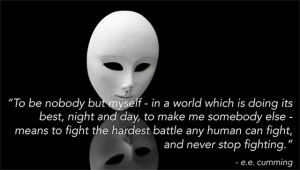A recent Harvard Business Review article titled “The Authenticity Paradox” claimed that “too rigid a definition of authenticity can get in the way of effective leadership”. But I would say that, on the contrary, too loose a definition of authenticity disables leadership – but, of course, it depends what you mean by authenticity and leadership.
I have two issues with this article. Firstly it relies on notions of leadership and authenticity which I find problematic and secondly, it prioritises a thinking, logically-reasoned or learned view of the world which does not seem to admit the potential for intuitive-knowing, the spiritual nature of our humanity.
Leadership?
The first two examples in the article reference people trying to cope with leadership challenges in organisations that appear to support a leader-follower construct of leadership – a tired construct that owes its continuance in many respects to the ongoing challenge of separating leadership from management. In both the cases quoted, the position of the ‘leaders’ would probably have been quite different if a shared leadership model was in play – a model that would have enabled them to present and manage their situation within a field of possibility where their colleagues embraced a shared accountability for co-creating mutually beneficial (win-win) outcomes. In contrast it seems that they found themselves (sadly) in an all too typical ‘dog-eat-dog’ world of corporate leadership where success is still so often measured in terms of the so-called leader’s ability to command, control or manipulate followers to deliver an acceptable outcome for their leaders.
It is no surprise that this style of leadership creates a very unwelcoming environment for the truly authentic leader. Indeed, I would argue that the emergence of true authenticity is only enabled by a shared leadership model, a way of co-leading that does not expect, for example, ‘leaders’ to “create a persona” in order to cope with, or indeed survive, the expectations of their ‘followers’. For when there are no followers, but only colleagues who share a common purpose, then the function of leadership is fundamentally altered. Leadership can no longer be about ‘me and them’, it must become more about ‘we and us’; the focus shifts from expecting me to succeed to helping others to succeed. To read more about this construct of enabling shared leadership, please refer to my recent post “Leadership is about helping other people to succeed”
Authenticity?
The article essentially proposes authenticity as an evolving learned construct, a view of self that changes over time as a result of both introspective and extrospective experience – an emergent sense of self that is transient and indefinite and, therefore, should not be relied upon to anchor or guide ‘leadership behaviour’.
Apparently, would-be leaders who choose to rely on their internal authenticity-compass (called “true-to-selfers”?), will face particular leadership challenges. They will, for example, have difficulty “choosing between what is expected, and therefore effective, and what feels authentic”; they will be challenged when “carefully curating a persona…that doesn’t clash with their private sense of self”; they will “tend to express what they really feel even when it runs counter to situational demands”; and they will “often find the process of getting buy-in distasteful because it feels artificial and political”. In other words, being a ‘true-to-selfer’ is likely to get in the way of being a ‘good leader’. Endeavouring to be authentic may result in ‘leadership responses’ that are unfamiliar to and perhaps unacceptable to both your followers and your leaders – conflicting with predictable patterns of the past and challenging what is expected, what looks best, what usually works etc.
But what if we define authenticity differently? What if our true self is defined by our life purpose, the essence of who we are and our highest intention for our existence on this planet? What if this is something that we ‘know’, a truth that is discovered and not learned, an intuitive understanding of who we are, a sense of self that is always true in the present?
We could then define authenticity as simply ‘being on purpose’, a way of being that always resonates with the truth of who we are.
This is clearly not a loose, adaptable definition of authenticity. It is a demanding and potentially difficult construct that challenges us to maintain an authentic presence, to be ourselves, not just in a leadership role but also as an individual participant within our communities.
And, where this rigid attachment to authenticity presents our true self within a community that enjoys enabling-shared leadership, it will not be necessary to choose “what doesn’t feel authentic”, present a “curated persona”, refrain from “expressing what we really feel” or struggle with “getting buy-in” from our colleagues. Within these communities the differences we present that may challenge others, the status quo or community norms, will be seen as opportunities for co-learning, not as potentially damaging transgressions of ‘community rules’.
It seems to me that faking who we are (adapting our authenticity) in order to sustain an outdated construct of leadership simply denies the real potential of genuine authentic leadership.


Leave A Comment